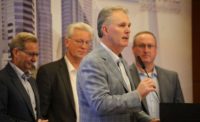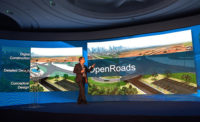The introduction of a cloud-based, automatic change synchronization system for composite project models captured great attention at a Bentley Systems Year in Infrastructure conference in Singapore in early October, as attendees quickly began to discuss what new things they could accomplish with the tool.
Conference attendees soaked up a deluge of announcements of product improvements—delivered, promised, or planned—as well as strategic alliances formed and acquisitions made; and they heard users present case studies to show how workflows and project delivery are improving through the implementation of new technologies.
But the announcement of a soon-to-be-released, cloud-based digital workflow and change-management innovation called iModelHub, which will add dynamic change-management capabilities and auto-synchronization to distributed ProjectWise iModels, captured the attention of users from across all sectors served by the company’s engineering software and process management tools.
iModels were introduced in 2009 to let users of Bentley’s ProjectWise design integration services gather related project files from disparate authoring tools and package static, vendor-agnostic views of their contents for distribution to project teams. The use of iModels cuts across all sectors, but they are employed extensively in the oil and gas sector, says Ann-Marie Walters, the Bentley marketing director for products serving oil and gas, and the mining and manufacturing industries. She says some EPCs generate several thousand iModels a day for work packaging.
Keith Bentley, company founder, CTO and the creator of the iModelHub concept, says the new active synchronization capability is part of iModel 2.0, which he describes as both a cloud platform and the iModel cloud service. "iModels are a way to collect large sets of information for a single project or single asset, into a single file. An iModel in the 2.0 world is a relational database as well as a file. With iModel Bridge, whenever [customers] use ProjectWise, they are using the Bridge to update the iModel Hub, [which is] a timeline of the changes. The iModel is everywhere in many many copies on computers everywhere, as well as on the cloud."
He says for users, implementation will not require changes to existing BIM applications or processes, but will simply enable the new capability by activating “iModel bridges” which will be automatically triggered in ProjectWise as it processes files into iModel containers. The bridges will enable the iModel hub to capture changes to existing data on a timeline and synchronize and distribute the changes to update iModels already distributed to the project community.
In response to questions of how users should get ready for the new capability, chief product officer Bhupinder Singh said, "All you need to do is turn on your iModel Bridges when they become available. “We’re looking for a few people eager to get started with this at the beginning of next year,” he says.
Conference attendee Nour Kassassir, CIO of the Middle East and Africa Division of Parsons, observed that the iModelHub will help consultants “manage change” on their projects. If an engineer does “30% deliverables and then 60% deliverables, and there is a change in scope in between,” for example, he or she could use the iModelHub to “track those deltas and report back to the client” on how the changes in scope affected cost and schedule, Kassassir said. Carey Mann, Bentley Chief Marketing Officer, added that those are the kinds of things that get obscured, “that Keith Bentley referred to as ‘dark data.’ From the owner’s perspective and the project delivery team’s perspective there’s that tension about what is really happening here, and if we can shine a light on it and everybody can see the impact of change, it’s going to make it easier to collaborate.”
ALLIANCE PARTNERS EXTEND INITIATIVES
Bentley alliance partners Microsoft, Bureau Veritas, Siemens, and Topcon Positioning Group all announced expanded initiatives with the software vendor. Bentley is leveraging the global system of Microsoft Azure Cloud servers as a platform for its digital initiatives, and it cites the availability of both private and public cloud options as one of the important options that help it meet a variety of customer needs. CEO Greg Bentley noted in his opening remarks that Azure has just opened a data center in Singapore, whose technologically innovative and ambitious, government-backed drive to support infrastructure development nevertheless has tight restrictions on the storage locations of its data. The vendor’s partnership with Microsoft helps it serve those requirements and needs.
Bentley Systems and Topcon Positioning Group announced they are moving into the second stage of their alliance to bridge design and field construction. CEO Greg Bentley calls it the “constructioneering digital workflow” where engineering, surveying and construction are a continuous process rather than steps that are handed off from one to another.
First, Bentley describes, Topcon Unmanned Aerial Vehicles capture the digital context of a construction site and, using and cloud services, bring the reality meshes into Bentley OpenRoads or OpenRail tools for design development. Then the design goes back to the machine-control devices for the heavy civil construction and then back again from the positioning device’s record into an asset management tool for the owner.
Topcon CEO Ray O’Conner said major equipment manufacturers from Caterpillar to Komatsu to John Deere to Volvo are integrating automated systems into their machines. “We are seeing exponential growth,” he said, “and the price point for systems that used to cost about $100,000 is coming down rapidly.” But if we don’t get the engineering side and the construction side calibrated together, we won’t solve the entire workflow problem, he added, which is why Bentley and Topcon are partnering to work on “solving the entire process.”
Eric Law, Bentley’s senior director of construction product management, explained that the first year of the partnership was about getting the “tools to work together.” With the active launch here at YII, the partners have two pilot projects in Australia “ready to go and probably another half dozen interested in it.”
Dustin Parkman, vice president of product development for Bentley’s road, rail and site product division, added, “What we’ve done is to integrate our two cloud platforms,” Bentley’s design platform with ProjectWise and Topcon’s Magnet Enterprise cloud for jobsite communications and management. Magnet manages deliverables, fleet, final surveys, stakeouts as well as all of the machine activities such as grading, paving and piling. “The clouds enable us to seamlessly exchange information in a managed workflow,” Parkman said. He added that with iModels, all the details can be delivered as digital-managed data from OpenRoads or OpenRail directly to the superintendent—bypassing any paper workflow. “The benefit is improved accuracy, saving time, saving iterations and at the end of the day saving cost to the owner,” Parkman pointed out.
To educate the audience, Bentley and Topcon are launching a “constructioneering academy,” where they will set up a full day of drone and equipment operations at Topcon’s facility in Livermore, Calif., and at a facility in Australia, where users can come and fly the drones, capture and process the data, do some design work, send those designs out to the equipment and watch the equipment move dirt.
Another Alliance partner, Helmuth Ludwig, Siemens global head of information technology, discussed how his company has been investing jointly with Bentley in in bringing their product portfolios forward for “customers in mobility, building technologies, process industries, and power and gas” among other sectors. Greg Bentley “coined a term that I like—industrializing infrastructure—to describe taking the dramatic productivity improvements of industry into infrastructure construction,” Ludwig said.
It is being enabled by several technologies like artificial intelligence, virtual reality and 3D printing all hitting a tipping point at the same time. “And this allows for not just optimizing the design process of a product, or the manufacturing process, but also how a product system is used in a completely integrated fashion. We go through all the steps from product design to service—and then go backward and integrate this with a digital twin,” he added.
To demonstrate the benefit, Ludwig gave the example of monitoring the performance of a plant and discovering that there is increased energy intake in one of the pumps. “What could be happening?” he asked. Operators could feed data gathered back into the design process, do simulations and optimize the best solution. If the change required a new damper, the operators could 3-D print it, install it and then keep on monitoring performance.
The real power of the digital twin comes in helping operators, who have the right simulations tools in place, avoid the problem in the future. “This is where the partnership between Bentley and Siemens adds enormous value because it allows you also to drill forward and make much better decisions” in future designs, Ludwig explained.












Post a comment to this article
Report Abusive Comment